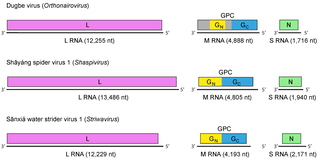
Bunyavirales is an order of segmented negative-strand RNA viruses with mainly tripartite genomes. Member viruses infect arthropods, plants, protozoans, and vertebrates. It is the only order in the class Ellioviricetes. The name Bunyavirales derives from Bunyamwera, where the original type species Bunyamwera orthobunyavirus was first discovered. Ellioviricetes is named in honor of late virologist Richard M. Elliott for his early work on bunyaviruses.
Luteoviridae was a family of viruses. The family was abolished in 2020 based on evidence that its three genera and seven species unassigned to a genus belonged to two other, existing families.

Duck plague is a worldwide disease caused by Anatid alphaherpesvirus 1 (AnHV-1) of the family Herpesviridae that causes acute disease with high mortality rates in flocks of ducks, geese, and swans. It is spread both vertically and horizontally—through contaminated water and direct contact. Migratory waterfowl are a major factor in the spread of this disease as they are often asymptomatic carriers of disease. The incubation period is three to seven days. Birds as young as one week old can be infected. DEV is not zoonotic.

Orthonairovirus is a genus of viruses in the family Nairoviridae of the order Bunyavirales that include viruses with circular, negative-sense single stranded RNA. It got its name from the Nairobi sheep disease that affects the gastrointestinal tracts of sheep and goats. The vast majority, and perhaps all viruses in this genus are tick-borne viruses that can have human or other vertebrate hosts.
Kupe orthonairovirus, also called Kupe virus, is a species of virus in the genus Orthonairovirus.

Ampullaviridae is a family of viruses that infect archaea of the genus Acidianus. Only one genus in this family has been described, Bottigliavirus, which contains three species. The name of the family and genus is derived from the Latin word for bottle, ampulla, due to the virions having the shape of a bottle. The family was first described during an investigation of the microbial flora of hot springs in Italy.
Hukuchivirus is a genus of double-stranded DNA viruses that infect thermophilic bacteria. The genus was previously named Gammasphaerolipovirus.
Abu Mina orthonairovirus, also called Abu Mina virus (ABMV), is a species of virus in the genus Orthonairovirus. This virus has not been reported to cause disease in humans.
In 1954 the Hazara orthonairovirus, one of the 34 tick-borne viruses of the genus Orthonairovirus, was discovered in Pakistan in the Ixodes tick native to that region. Today this virus is studied in mice in an attempt to develop treatments for the highly pathogenic Crimean-Congo Hemorrhagic Fever virus.
Turriviridae is a family of viruses; it contains only one genus, Alphaturrivirus. The archaea Sulfolobus solfataricus serve as natural hosts. There are two species in the genus Alphaturrivirus.
Phasmaviridae is a family of viruses with negative stranded RNA genomes associated with insect hosts. They are a member of the order Bunyavirales. Phasmaviruses were first discovered in phantom midges of the genus Chaoborus in 2014.

Nairoviridae is a family of viruses in the order Bunyavirales. Its name derives from Nairobi sheep disease, caused by the member Nairobi sheep disease orthonairovirus.
Yogue orthonairovirus, also called Yogue virus, is a species of virus in the genus Orthonairovirus. Its only known host is Rousettus aegyptiacus.
Kasokero orthonairovirus is a species of virus in the genus Orthonairovirus. Its only known host is the fruit bat Rousettus aegyptiacus. The virus takes its name from the Kasokero Cave in Uganda, where it was first collected.
The Nairobi sheep disease orthonairovirus (NSDV), also known as Ganjam virus is a species in the genus Orthonairovirus belonging to the Nairobi sheep disease serogroup. NSDV's known hosts belong to the hard tick family Ixodidae, including Rhipicephalus appendiculatus, and Amblyomma variegatum, and afflict sheep and goats naturally. The virus is in the family Nairoviridae and order Bunyavirales.
Puffin Island virus, is a strain of Dugbe orthonairovirus belonging to the Hughes serogroup.
Artashat orthonairovirus, also called Artashat virus (ARTSV), is a species in the genus Orthonairovirus. It was first isolated in Armenia in 1972 from Ornithodoros alactagalis, a soft tick of the family Argasidae.
The Tofla virus is a strain of Hazara orthonairovirus in the genus Orthonairovirus belonging to the Crimean-Congo hemorrhagic fever serogroup. It was isolated from Ixodid in Japan in 2016.
Farallon virus is a strain of Hughes orthonairovirus in the genus Orthonairovirus belonging to the Hughes serogroup. A known host of the virus is Ornithodoros. The virus is named after the Farallon Islands.
Spheniscid alphaherpesvirus 1 (SpAHV-1) is a species of virus in the genus Mardivirus, subfamily Alphaherpesvirinae, family Herpesviridae, and order Herpesvirales.




